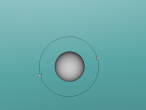3D Model of Fluorine Atom
3D Models of Atom Blog – Fluorine
Introduction:
The topic of this blog is going to be about an atom i.e. fluorine. Using a program called VRMath2.0, my group created a 3D model of fluorine which included the nucleus of the atom and its outer shells. This blog will include the following components: a 3D model of the atom Fluorine, a description on the composition, structure and characteristics of Fluorine, questions that I wish to investigate further and the difficulties that I experienced throughout the programming.
Fluorine is a chemical element represented by the symbol ‘F’ and has an atomic number of 9. It is classified as a non-metal and is the first element in the family of halogen gases. Given that it is the top element in the Halogen Group, it is the most electronegative element and therefore is very reactive. (Feldman, R. & Marsden, S., 2015) There are a few common usage of Fluorine and this element can be found in a variety of items and objects including rocket fuel, refrigeration fluids and toothpaste (helps to prevent tooth decay). (Chem4Kids, 2016)
Composition and Structure:
Fluorine (F) is the first element in the Halogen group (group 17) in the periodic table. It has an atomic number of 9, meaning that it consists of 9 protons and 9 electrons. Since its atomic weight is 18.998 grams, it can be assumed that there are 10 neutrons within the nucleus of the atom. Fluorine has two outer shells, the first shell consisting of 2 electrons positioned directly opposite from each other, and the second shell consisting of 7 electrons evenly spaced out from each other in a circle. Since the optimal configuration of the outer shell contains 8 electrons, fluorine is so close to the ideal electron configuration, such that the electrons are held very tightly to the nucleus. However, it still means that fluorine is unstable as it doesn’t exactly follow the ideal electron configuration.
Characteristics:
Fluorine, being the 13th most common element in the Earth’s crust is a dangerously reactive gas. Fluorine appears as a very pale yellow-green gas and is in a gaseous state at room temperature (20°C). Its melting point is -219.67˚C and its boiling point is -188.11˚C. It is the most reactive of all elements and quickly attacks all metals, hence this is why steel wool burst into flames when exposed to fluorine. (Royal Society of Chemistry, 2016). Fluorine is also the most electronegative element; given that it is the top element in the Halogen group. Because of its intense reactivity, elemental fluorine is never found in nature and no other chemical element can displace fluorine from its compounds. Fluorine bonds with almost any element, both metals and non-metals, because it is a very strong oxidizing agent. (Feldman, R. & Marsden, S., 2015) As a result, it attracts the highest number of electrons of all elements except chlorine. Compounds formed by fluorine and all other elements, except neon and helium, are known as fluorides. (Elements Database, 2015)
Questions and Further Information:
Based on prior knowledge, I know that fluorine is a very reactive element. However, I’ve always pondered whether fluorine has been used solely for its reactive purposes or if fluorine has been used for other reasons apart from its reactive characteristic.
For further information, please refer to the following websites:
- http://www.rsc.org/periodic-table/element/9/fluorine
- http://www.physlink.com/education/askexperts/ae387.cfm
- http://education.jlab.org/itselemental/ele009.html
- http://www.chem4kids.com/files/elements/009_speak.html
- http://www.chemguide.co.uk/inorganic/group7/properties.html
Difficulties and Improvements:
Throughout the programming of the 3D model of the fluorine atom, my group experienced a major issue regarding the spinning animation of the two outer. In regards to the spinning animation, the two outer shells would sometimes spin in the same direction and rotate simultaneously and thus, would represent an inaccurate model of the Fluorine atom. Consequently, my group was provided with help from a peer who assisted us in producing a piece of code that would effectively spin and rotate both outer shells in a different direction. This piece of code that ‘spun the outer shells’ eventually made me understand how to properly incorporate the ‘spin command’ in a model of an atom, which would allow the outer shells to spin in a random direction.
Despite the lack of time for the students to be extensively taught how to accurately program a 3D model of an atom or molecule, my group’s 3D model of a fluorine atom displayed decently accurate aspects of a proper atom. However, to improve the accuracy of the 3D model of an atom, my group could have calculated the specific gap between the nucleus and the first outer shell. This is because my group did not know where to position the outer shell in relation to the position of the nucleus. If this aspect of the atom was achieved, this 3D model of fluorine would have accurately resembled a fluorine atom.
Links to 3D Model and Logo Program
The following link will lead to a 3D Model of Fluorine:
The following link will lead to the logo programming of the 3D Model of Fluorine:
Reference List:
Chem4Kids. (2016). Fluorine. Retrieved July 25, 2016 from
http://www.chem4kids.com/files/elements/009_speak.html
Royal Society of Chemistry. (2016). Fluorine. Retrieved July 28, 2016
http://www.rsc.org/periodic-table/element/9/fluorine
Feldman, R. & Marsden, S. (2015). Chemistry of Fluorine. Retrieved July 28, 2016
Elements Database Periodic Table. (2015). Fluorine. Retrieved July 28, 2016 from
http://www.elementsdatabase.com/Fluorine-F-9-element/
























Comments
Feedback
Good use of in-text. I liked reading your reflection